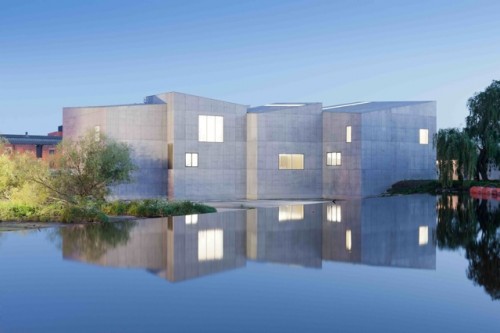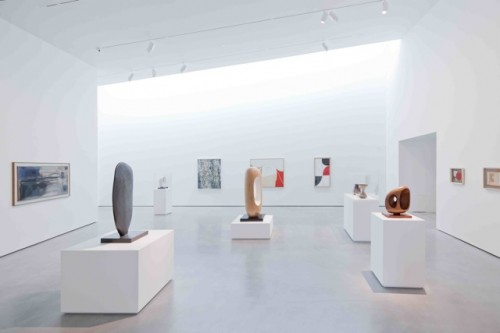
Rose George goes for a wander around the newly opened Hepworth Gallery, Wakefield . . .
At Wakefield Girls’ High School, we didn’t have a surfeit of famous alumnae. The most famous by far was Barbara Hepworth who was, we knew, a sculptor, though it was odd to imagine her decades earlier suffering in the art rooms where we suffered in the effort to produce anything worthy. And we knew also that she had died in a fire at her studio, somewhere that was not Wakefield. Later, I learned that the other place was St. Ives, where she spent 26 years, and where she died. But St. Ives doesn’t have a swanky, David Chipperfield-designed rather gorgeous new gallery rising from the banks of a river, behind glorious weeping willows. Wakefield does, now.
The press event was yesterday. The invitation forgot to mention that there was no parking on site, something I learned five minutes before the press conference began, so my introduction to Wakefield’s new gem consisted of a hurried rush over the sleek grey – there is a lot of grey – footbridge, to meet a group coming the other way, back to a big group standing by the riverside where I had parked, listening to a grey-haired man, next to two coaches. For some reason I’d taken them for lost tourists, not the assembled art press corps brought up from London and bussed from the station to the gallery (so that all that was missing was an armed guard). The grey-haired man was David Chipperfield, architect of the Hepworth, but I can’t tell you what he said because all I heard was “and that’s my five minutes.” I can tell you what his building looks like, though: grey (I told you), interlocking boxes, consisting of the kind simplicity that is fiendishly complicated to create. I know this from having worked in Benetton’s Tadao Ando building in Treviso, Italy, for two years. So I know about grey, and that you put blu-tack on burnished concrete walls at your own risk. The best thing about the Hepworth’s exterior is that though it shouldn’t fit this not particularly nice part of Wakefield – there may be the 14th century Chantry Chapel, but it is blackened by the passing traffic on the congested Doncaster Road – it does. It rises peaceably from the white-capped water of the weir on the Calder, near magnificent weeping willows. Building near a riverbed, of course, made the building even more difficult, and means that its soothing serenity – if you like grey – is even more praiseworthy. His building, said Chipperfield, was dipping its toes into the river. And it does it without losing its balance.
Inside, there are free tote bags and coffee, and a press conference in an auditorium overlooking the weir, to which several heads kept turning, because that rushing, shooting water was sometimes more compelling than words. The Hepworth is an achievement, to be sure, and though of course it was team work from directors and funders and Art Councils and lottery payers, it is understandable, said Wakefield council leader Peter Box, that Wakefield wags have called it the bunker, but also Peter’s Box, because the council has pushed and pushed for it, along with Trinity Walk, and here it is, finally, bunker or not.
Two tour groups depart around the galleries. I take the less popular, led by Hepworth director Simon Wallis, a curator and an architect from Chipperfield’s practice. The other is led by Chipperfield and is packed. But I don’t regret my choice, because the interior of the building is less arresting than the exterior, which is how it should be, when what you want now is the art. And, though I am not wholly and always a fan of Barbara Hepworth’s sculpture, what art this is. Beautiful things done with stone and bronze and wood, wrapped in nothing but space and light. The building retreats and the art steps forward. So the architecture becomes nothing spectacular and nothing you haven’t seen before – grey, light, space, who would have thought it – but the whole is something different, because here are Barbara Hepworth’s tools, and the plaster models she used, donated by the Hepworth family in what all the speakers at the press conference called the Hepworth Gift as if it were a Doctor Who villain. There is the huge model for the huge Winged Figure, still clinging to the side of John Lewis department store off Oxford Street, and in other galleries complementary art that may have inspired Hepworth, or may have just been contemporary. Some Henry Moore, of course. A spooky, lovely Brancusi Danaide from 1918. A St. Ives gallery featuring paintings of her adopted home. Her native city gets a smaller homage next door, in the form of the Wakefield topographical gallery, which shows a borrowed Turner painting of the Chantry chapel in its bucolic days, opposite the chapel itself seen from the window; and the Gott collection of local topographical works, shown in bound volumes whose pages, said the curator, will be regularly turned.
This is important, said Wallis. The contents of Hepworth will be continually refreshed because he wants people to come more than once a year. Even if they are like the good people of Wakefield in 1963, who feature in a Daily Mirror article about Henry Moore’s first show in his home city. Entitled “Henry packs ’em in,” the article features several bemused residents of Wakefield, looking at those modern shapes and wondering what was what. Wakefield’s residents may still not “get” contemporary art, and they may not “get” the bunker, or Peter’s Box. But they may love it anyway, because all of it – the work, the light, the space – works like a sensory embrace. Subtle, persuasive, refreshing. And even if they are not seduced, they could agree with the words of Mrs Elsie Hemmingway in 1963, peering at Moore’s Reclining Figure through horn-rimmed spectacles, then saying with generosity, “Well, you can’t get away from it. It’s clever.”
